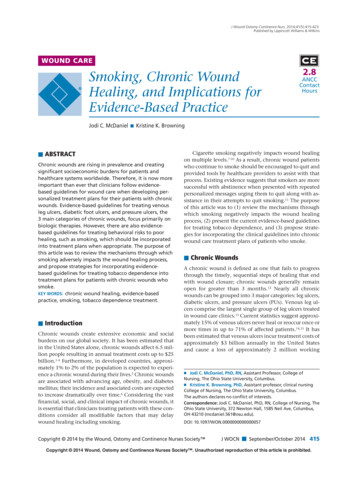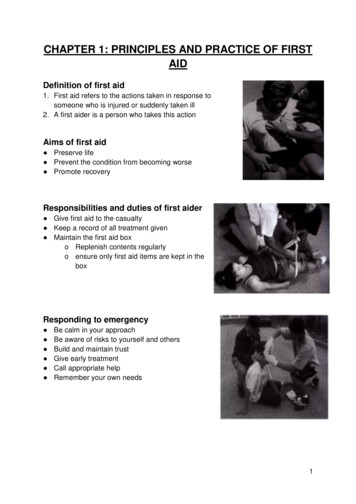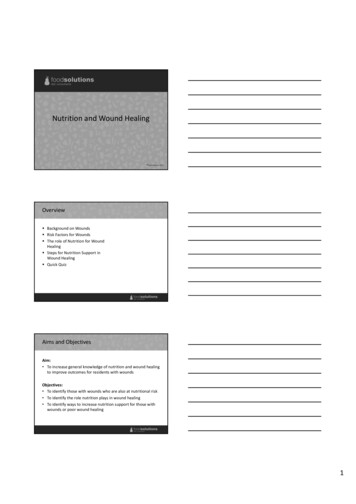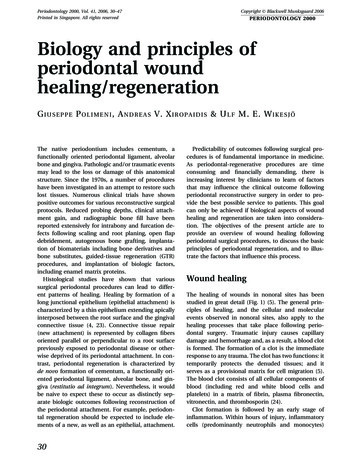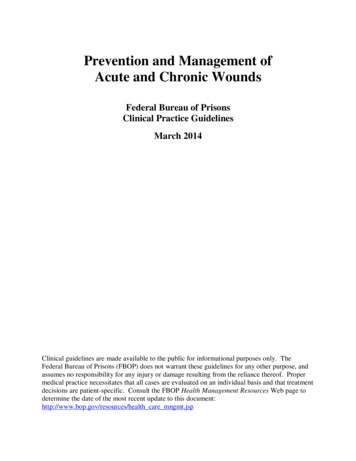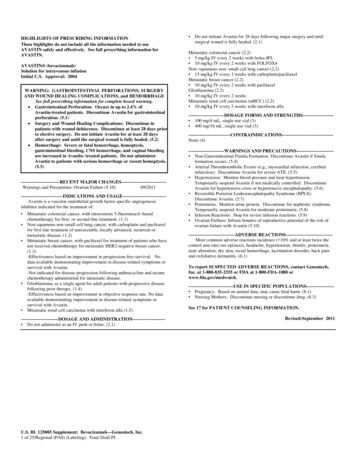
Transcription
HIGHLIGHTS OF PRESCRIBING INFORMATIONThese highlights do not include all the information needed to useAVASTIN safely and effectively. See full prescribing information forAVASTIN.AVASTIN (bevacizumab)Solution for intravenous infusionInitial U.S. Approval: 2004WARNING: GASTROINTESTINAL PERFORATIONS, SURGERYAND WOUND HEALING COMPLICATIONS, and HEMORRHAGESee full prescribing information for complete boxed warning. Gastrointestinal Perforation: Occurs in up to 2.4% ofAvastin-treated patients. Discontinue Avastin for gastrointestinalperforation. (5.1) Surgery and Wound Healing Complications: Discontinue inpatients with wound dehiscence. Discontinue at least 28 days priorto elective surgery. Do not initiate Avastin for at least 28 daysafter surgery and until the surgical wound is fully healed. (5.2) Hemorrhage: Severe or fatal hemorrhage, hemoptysis,gastrointestinal bleeding, CNS hemorrhage, and vaginal bleedingare increased in Avastin- treated patients. Do not administerAvastin to patients with serious hemorrhage or recent hemoptysis.(5.3)-------------------------RECENT MAJOR CHANGES----------------------------Warnings and Precautions: Ovarian Failure S AND USAGE---------------------------Avastin is a vascular endothelial growth factor-specific angiogenesisinhibitor indicated for the treatment of: Metastatic colorectal cancer, with intravenous 5-fluorouracil–basedchemotherapy for first- or second-line treatment. (1.1)Non-squamous non-small cell lung cancer, with carboplatin and paclitaxelfor first line treatment of unresectable, locally advanced, recurrent ormetastatic disease. (1.2)Metastatic breast cancer, with paclitaxel for treatment of patients who havenot received chemotherapy for metastatic HER2-negative breast cancer.(1.3)-Effectiveness based on improvement in progression-free survival. Nodata available demonstrating improvement in disease-related symptoms orsurvival with Avastin.-Not indicated for disease progression following anthracycline and taxanechemotherapy administered for metastatic disease.Glioblastoma, as a single agent for adult patients with progressive diseasefollowing prior therapy. (1.4)-Effectiveness based on improvement in objective response rate. No dataavailable demonstrating improvement in disease-related symptoms orsurvival with Avastin.Metastatic renal cell carcinoma with interferon alfa (1.5)------------------------DOSAGE AND ADMINISTRATION-------------------- Do not administer as an IV push or bolus. (2.1)U.S. BL 125085 Supplement: Bevacizumab Genentech, Inc.1 of 25/Regional (PAS) (Labeling): Final Draft PI Do not initiate Avastin for 28 days following major surgery and untilsurgical wound is fully healed. (2.1)Metastatic colorectal cancer (2.2) 5 mg/kg IV every 2 weeks with bolus-IFL 10 mg/kg IV every 2 weeks with FOLFOX4Non squamous non small cell lung cancer (2.2) 15 mg/kg IV every 3 weeks with carboplatin/paclitaxelMetastatic breast cancer (2.2) 10 mg/kg IV every 2 weeks with paclitaxelGlioblastoma (2.2) 10 mg/kg IV every 2 weeksMetastatic renal cell carcinoma (mRCC) (2.2) 10 mg/kg IV every 2 weeks with interferon alfa-----------------------DOSAGE FORMS AND STRENGTHS------------------- 100 mg/4 mL, single use vial (3) 400 mg/16 mL, single use vial -----------------------------None (4)-----------------------WARNINGS AND PRECAUTIONS----------------------- Non-Gastrointestinal Fistula Formation: Discontinue Avastin if fistulaformation occurs. (5.4) Arterial Thromboembolic Events (e.g., myocardial infarction, cerebralinfarction): Discontinue Avastin for severe ATE. (5.5) Hypertension: Monitor blood pressure and treat hypertension.Temporarily suspend Avastin if not medically controlled. DiscontinueAvastin for hypertensive crisis or hypertensive encephalopathy. (5.6) Reversible Posterior Leukoencephalopathy Syndrome (RPLS):Discontinue Avastin. (5.7) Proteinuria: Monitor urine protein. Discontinue for nephrotic syndrome.Temporarily suspend Avastin for moderate proteinuria. (5.8) Infusion Reactions: Stop for severe infusion reactions. (5.9) Ovarian Failture: Inform females of reproductive potential of the risk ofovarian failure with Avastin (5.10)------------------------------ADVERSE REACTIONS-----------------------------Most common adverse reactions incidence ( 10% and at least twice thecontrol arm rate) are epistaxis, headache, hypertension, rhinitis, proteinuria,taste alteration, dry skin, rectal hemorrhage, lacrimation disorder, back painand exfoliative dermatitis. (6.1)To report SUSPECTED ADVERSE REACTIONS, contact Genentech,Inc. at 1-888-835-2555 or FDA at 1-800-FDA-1088 --USE IN SPECIFIC POPULATIONS----------------- Pregnancy: Based on animal data, may cause fetal harm. (8.1) Nursing Mothers: Discontinue nursing or discontinue drug. (8.3)See 17 for PATIENT COUNSELING INFORMATION.Revised:September 2011
FULL PRESCRIBING INFORMATION: CONTENTS*WARNING: GASTROINTESTINAL PERFORATIONS,SURGERY AND WOUND HEALING COMPLICATIONS, andHEMORRHAGE1 INDICATIONS AND USAGE1.1Metastatic Colorectal Cancer1.2Non-Squamous Non Small Cell Lung Cancer1.3Metastatic Breast Cancer1.4Glioblastoma1.5Metastatic Renal Cell Carcinoma2 DOSAGE AND ADMINISTRATION2.1Administration2.2Recommended Doses and Schedules2.3Preparation for Administration2.4Dose Modifications3 DOSAGE FORMS AND STRENGTHS4 CONTRAINDICATIONS5 WARNINGS AND PRECAUTIONS5.1Gastrointestinal Perforations5.2Surgery and Wound Healing Complications5.3Hemorrhage5.4Non-Gastrointestinal Fistula Formation5.5Arterial Thromboembolic Events5.6Hypertension5.7Reversible Posterior Leukoencephalopathy Syndrome(RPLS)5.8Proteinuria5.9Infusion Reactions5.10 Ovarian Failure6 ADVERSE REACTIONSU.S. BL 125085 Supplement: Bevacizumab Genentech, Inc.2 of 25/Regional (PAS) (Labeling): Final Draft PI7810111213141617*6.1Clinical Trial Experience6.2Immunogenicity6.3Postmarketing ExperienceDRUG INTERACTIONSUSE IN SPECIFIC POPULATIONS8.1Pregnancy8.3Nursing Mothers8.4Pediatric Use8.5Geriatric Use8.6Females of Reproductive PotentialOVERDOSAGEDESCRIPTIONCLINICAL PHARMACOLOGY12.1 Mechanism of Action12.3 PharmacokineticsNONCLINICAL TOXICOLOGY13.1 Carcinogenesis, Mutagenesis, Impairment of Fertility13.2 Animal Toxicology and/or Pharmacology13.3 Reproductive and Developmental ToxicologyCLINICAL STUDIES14.1 Metastatic Colorectal Cancer (mCRC)14.2 Unresectable Non Squamous Non Small Cell LungCancer (NSCLC)14.3 Metastatic Breast Cancer (MBC)14.4 Glioblastoma14.5 Metastatic Renal Cell Carcinoma (mRCC)HOW SUPPLIED/STORAGE AND HANDLINGPATIENT COUNSELING INFORMATIONSections or subsections omitted from the Full Prescribing Information arenot listed.
1FULL PRESCRIBING NG: GASTROINTESTINAL PERFORATIONS, SURGERY AND WOUNDHEALING COMPLICATIONS, and HEMORRHAGEGastrointestinal PerforationsThe incidence of gastrointestinal perforation, some fatal, in Avastin-treated patients rangesfrom 0.3 to 2.4%. Discontinue Avastin in patients with gastrointestinal perforation. [SeeDosage and Administration (2.4), Warnings and Precautions (5.1).]Surgery and Wound Healing ComplicationsThe incidence of wound healing and surgical complications, including serious and fatalcomplications, is increased in Avastin-treated patients. Discontinue Avastin in patients withwound dehiscence. The appropriate interval between termination of Avastin and subsequentelective surgery required to reduce the risks of impaired wound healing/wound dehiscence hasnot been determined. Discontinue at least 28 days prior to elective surgery. Do not initiateAvastin for at least 28 days after surgery and until the surgical wound is fully healed. [SeeDosage and Administration (2.4), Warnings and Precautions (5.2), Adverse Reactions (6.1).]HemorrhageSevere or fatal hemorrhage, including hemoptysis, gastrointestinal bleeding, central nervoussystems (CNS) hemorrhage, epistaxis, and vaginal bleeding occurred up to five-fold morefrequently in patients receiving Avastin. Do not administer Avastin to patients with serioushemorrhage or recent hemoptysis. [See Dosage and Administration (2.4), Warnings andPrecautions (5.3), Adverse Reactions (6.1).]231 INDICATIONS AND USAGE1.1 Metastatic Colorectal Cancer (mCRC)Avastin is indicated for the first- or second-line treatment of patients with metastatic carcinoma ofthe colon or rectum in combination with intravenous 5-fluorouracil–based chemotherapy.1.2 Non-Squamous Non–Small Cell Lung Cancer (NSCLC)Avastin is indicated for the first-line treatment of unresectable, locally advanced, recurrent ormetastatic non–squamous non–small cell lung cancer in combination with carboplatin and paclitaxel.1.3 Metastatic Breast Cancer (MBC)Avastin is indicated for the treatment of patients who have not received chemotherapy formetastatic HER2-negative breast cancer in combination with paclitaxel.The effectiveness of Avastin in MBC is based on an improvement in progression free survival.There are no data demonstrating an improvement in disease-related symptoms or increased survivalwith Avastin. [See Clinical Studies (14.3).]Avastin is not indicated for patients with breast cancer that has progressed following anthracyclineand taxane chemotherapy administered for metastatic disease.1.4 GlioblastomaAvastin is indicated for the treatment of glioblastoma with progressive disease in adult patientsfollowing prior therapy as a single agent.The effectiveness of Avastin in glioblastoma is based on an improvement in objective responserate. There are no data demonstrating an improvement in disease-related symptoms or increasedsurvival with Avastin. [See Clinical Studies (14.4).]1.5 Metastatic Renal Cell Carcinoma (mRCC)Avastin is indicated for the treatment of metastatic renal cell carcinoma in combination withinterferon 6U.S. BL 125085 Supplement: Bevacizumab Genentech, Inc.3 of 25/Regional (PAS) (Labeling): Final Draft PI
72737475767778798081828384858687888990919293942 DOSAGE AND ADMINISTRATION2.1 AdministrationDo not administer as an intravenous push or bolus. Administer only as an intravenous (IV)infusion. Do not initiate Avastin until at least 28 days following major surgery. Administer Avastin afterthe surgical incision has fully healed. First infusion: Administer infusion over 90 minutes. Subsequent infusions: Administer second infusion over 60 minutes if first infusion is tolerated;administer all subsequent infusions over 30 minutes if infusion over 60 minutes is tolerated.2.2 Recommended Doses and SchedulesPatients should continue treatment until disease progression or unacceptable toxicity.Metastatic Colorectal Cancer (mCRC)The recommended doses are 5 mg/kg or 10 mg/kg every 2 weeks when used in combination withintravenous 5-FU-based chemotherapy. Administer 5 mg/kg when used in combination with bolus-IFL. Administer 10 mg/kg when used in combination with FOLFOX4.Non-Squamous Non-Small Cell Lung Cancer (NSCLC)The recommended dose is 15 mg/kg every 3 weeks in combination with carboplatin andpaclitaxel.Metastatic Breast Cancer (MBC)The recommended dose is 10 mg/kg every 2 weeks in combination with paclitaxel.GlioblastomaThe recommended dose is 10 mg/kg every 2 weeks.Metastatic Renal Cell Carcinoma (mRCC)The recommended dose is 10 mg/kg every 2 weeks in combination with interferon alfa.2.3 Preparation for AdministrationUse appropriate aseptic technique. Parenteral drug products should be inspected visually forparticulate matter and discoloration prior to administration, whenever solution and container permit.Withdraw necessary amount of Avastin and dilute in a total volume of 100 mL of 0.9% SodiumChloride Injection, USP. Discard any unused portion left in a vial, as the product contains nopreservatives.DO NOT ADMINISTER OR MIX WITH DEXTROSE SOLUTION.2.4 Dose ModificationsThere are no recommended dose reductions.Discontinue Avastin for: Gastrointestinal perforations (gastrointestinal perforations, fistula formation in thegastrointestinal tract, intra-abdominal abscess), fistula formation involving an internal organ[See Boxed Warning, Warnings and Precautions (5.1, 5.4).] Wound dehiscence and wound healing complications requiring medical intervention [SeeWarnings and Precautions (5.2).] Serious hemorrhage (i.e., requiring medical intervention) [See Boxed Warning, Warnings andPrecautions (5.3).] Severe arterial thromboembolic events [See Warnings and Precautions (5.5).] Hypertensive crisis or hypertensive encephalopathy [See Warnings and Precautions (5.6).] Reversible posterior leukoencephalopathy syndrome (RPLS) [See Warnings and Precautions(5.7).] Nephrotic syndrome [See Warnings and Precautions (5.8).]U.S. BL 125085 Supplement: Bevacizumab Genentech, Inc.4 of 25/Regional (PAS) (Labeling): Final Draft PI
9596979899100101102Temporarily suspend Avastin for: At least 4 weeks prior to elective surgery [See Warnings and Precautions (5.2).] Severe hypertension not controlled with medical management [See Warnings and Precautions(5.6).] Moderate to severe proteinuria pending further evaluation [See Warnings and Precautions(5.8).] Severe infusion reactions [See Warnings and Precautions (5.9).]1031041051063 DOSAGE FORMS AND STRENGTHS100 mg per 4 mL single-use vial400 mg per 16 mL single-use vial1071081094 CONTRAINDICATIONSNone.1105 WARNINGS AND PRECAUTIONS5.1 Gastrointestinal PerforationsSerious and sometimes fatal gastrointestinal perforation occurs at a higher incidence in Avastintreated patients compared to controls. The incidence of gastrointestinal perforation ranged from 0.3to 2.4% across clinical studies. [See Adverse Reactions (6.1).]The typical presentation may include abdominal pain, nausea, emesis, constipation, and fever.Perforation can be complicated by intra-abdominal abscess and fistula formation. The majority ofcases occurred within the first 50 days of initiation of Avastin.Discontinue Avastin in patients with gastrointestinal perforation. [See Boxed Warning, Dosageand Administration (2.4).]5.2 Surgery and Wound Healing ComplicationsAvastin impairs wound healing in animal models. [See Nonclinical Toxicology (13.2).] In clinicaltrials, administration of Avastin was not allowed until at least 28 days after surgery. In a controlledclinical trial, the incidence of wound healing complications, including serious and fatalcomplications, in patients with mCRC who underwent surgery during the course of Avastintreatment was 15% and in patients who did not receive Avastin, was 4%. [See Adverse Reactions(6.1).]Avastin should not be initiated for at least 28 days following surgery and until the surgical woundis fully healed. Discontinue Avastin in patients with wound healing complications requiring medicalintervention.The appropriate interval between the last dose of Avastin and elective surgery is unknown;however, the half-life of Avastin is estimated to be 20 days. Suspend Avastin for at least 28 daysprior to elective surgery. Do not administer Avastin until the wound is fully healed. [See BoxedWarning, Dosage and Administration (2.4).]5.3 HemorrhageAvastin can result in two distinct patterns of bleeding: minor hemorrhage, most commonlyGrade 1 epistaxis; and serious, and in some cases fatal, hemorrhagic events. Severe or fatalhemorrhage, including hemoptysis, gastrointestinal bleeding, hematemesis, CNS hemorrhage,epistaxis, and vaginal bleeding occurred up to five-fold more frequently in patients receiving Avastincompared to patients receiving only chemotherapy. Across indications, the incidence of Grade 3hemorrhagic events among patients receiving Avastin ranged from 1.2 to 4.6%. [See AdverseReactions U.S. BL 125085 Supplement: Bevacizumab Genentech, Inc.5 of 25/Regional (PAS) (Labeling): Final Draft PI
s or fatal pulmonary hemorrhage occurred in four of 13 (31%) patients with squamous cellhistology and two of 53 (4%) patients with non-squamous non-small cell lung cancer receivingAvastin and chemotherapy compared to none of the 32 (0%) patients receiving chemotherapy alone.In clinical studies in non small cell lung cancer where patients with CNS metastases whocompleted radiation and surgery more than 4 weeks prior to the start of Avastin were evaluated withserial CNS imaging, symptomatic Grade 2 CNS hemorrhage was documented in one of 83Avastin-treated patients (rate 1.2%, 95% CI 0.06% 5.93%).Intracranial hemorrhage occurred in 8 of 163 patients with previously treated glioblastoma; twopatients had Grade 3 4 hemorrhage.Do not administer Avastin to patients with recent history of hemoptysis of 1/2 teaspoon of redblood. Discontinue Avastin in patients with hemorrhage. [See Boxed Warning, Dosage andAdministration (2.4).]5.4 Non-Gastrointestinal Fistula FormationSerious and sometimes fatal non-gastrointestinal fistula formation involving tracheo-esophageal,bronchopleural, biliary, vaginal, renal and bladder sites occurs at a higher incidence inAvastin-treated patients compared to controls. The incidence of non-gastrointestinal perforation was 0.3% in clinical studies. Most events occurred within the first 6 months of Avastin therapy.Discontinue Avastin in patients with fistula formation involving an internal organ. [See Dosageand Administration (2.4).]5.5 Arterial Thromboembolic EventsSerious, sometimes fatal, arterial thromboembolic events (ATE) including cerebral infarction,transient ischemic attacks, myocardial infarction, angina, and a variety of other ATE occurred at ahigher incidence in patients receiving Avastin compared to those in the control arm. Acrossindications, the incidence of Grade 3 ATE in the Avastin containing arms was 2.4% compared to0.7% in the control arms. Among patients receiving Avastin in combination with chemotherapy, therisk of developing ATE during therapy was increased in patients with a history of arterialthromboembolism, or age greater than 65 years. [See Use in Specific Populations (8.5).]The safety of resumption of Avastin therapy after resolution of an ATE has not been studied.Discontinue Avastin in patients who experience a severe ATE. [See Dosage and Administration(2.4).]5.6 HypertensionThe incidence of severe hypertension is increased in patients receiving Avastin as compared tocontrols. Across clinical studies the incidence of Grade 3 or 4 hypertension ranged from 5-18%.Monitor blood pressure every two to three weeks during treatment with Avastin. Treat withappropriate anti-hypertensive therapy and monitor blood pressure regularly. Continue to monitorblood pressure at regular intervals in patients with Avastin-induced or -exacerbated hypertensionafter discontinuation of Avastin.Temporarily suspend Avastin in patients with severe hypertension that is not controlled withmedical management. Discontinue Avastin in patients with hypertensive crisis or hypertensiveencephalopathy. [See Dosage and Administration (2.4).]5.7 Reversible Posterior Leukoencephalopathy Syndrome (RPLS)RPLS has been reported with an incidence of 0.1% in clinical studies. The onset of symptomsoccurred from 16 hours to 1 year after initiation of Avastin. RPLS is a neurological disorder whichcan present with headache, seizure, lethargy, confusion, blindness and other visual and neurologicdisturbances. Mild to severe hypertension may be present. Magnetic resonance imaging (MRI) isnecessary to confirm the diagnosis of RPLS.Discontinue Avastin in patients developing RPLS. Symptoms usually resolve or improve withindays, although some patients have experienced ongoing neurologic sequelae. The safety ofU.S. BL 125085 Supplement: Bevacizumab Genentech, Inc.6 of 25/Regional (PAS) (Labeling): Final Draft PI
nitiating Avastin therapy in patients previously experiencing RPLS is not known. [See Dosageand Administration (2.4).]5.8 ProteinuriaThe incidence and severity of proteinuria is increased in patients receiving Avastin as compared tocontrols. Nephrotic syndrome occurred in 1% of patients receiving Avastin in clinical trials, insome instances with fatal outcome. [See Adverse Reactions (6.1).] In a published case series, kidneybiopsy of six patients with proteinuria showed findings consistent with thrombotic microangiopathy.Monitor proteinuria by dipstick urine analysis for the development or worsening of proteinuriawith serial urinalyses during Avastin therapy. Patients with a 2 or greater urine dipstick readingshould undergo further assessment with a 24-hour urine collection.Suspend Avastin administration for 2 grams of proteinuria/24 hours and resume whenproteinuria is 2 gm/24 hours. Discontinue Avastin in patients with nephrotic syndrome. Data froma postmarketing safety study showed poor correlation between UPCR (Urine Protein/CreatinineRatio) and 24 hour urine protein (Pearson Correlation 0.39 (95% CI 0.17, 0.57). [See Use in SpecificPopulations (8.5).] The safety of continued Avastin treatment in patients with moderate to severeproteinuria has not been evaluated. [See Dosage and Administration (2.4).]5.9 Infusion ReactionsInfusion reactions reported in the clinical trials and post-marketing experience includehypertension, hypertensive crises associated with neurologic signs and symptoms, wheezing, oxygendesaturation, Grade 3 hypersensitivity, chest pain, headaches, rigors, and diaphoresis. In clinicalstudies, infusion reactions with the first dose of Avastin were uncommon ( 3%) and severereactions occurred in 0.2% of patients.Stop infusion if a severe infusion reaction occurs and administer appropriate medical therapy.[See Dosage and Administration (2.4).]5.10 Ovarian FailureThe incidence of ovarian failure was higher (34% vs. 2%) in premenopausal women receivingAvastin in combination with mFOLFOX chemotherapy as compared to those receiving mFOLFOXchemotherapy alone for adjuvant treatment for colorectal cancer, a use for which Avastin is notapproved. Inform females of reproductive potential of the risk of ovarian failure prior to startingtreatment with Avastin. [See Adverse Reactions (6.1), Use in Specific Populations (8.6).]6 ADVERSE REACTIONSThe following serious adverse reactions are discussed in greater detail in other sections of thelabel: Gastrointestinal Perforations [See Boxed Warning, Dosage and Administration (2.4), Warningsand Precautions (5.1).] Surgery and Wound Healing Complications [See Boxed Warning, Dosage and Administration(2.4), Warnings and Precautions (5.2).] Hemorrhage [See Boxed Warning, Dosage and Administration (2.4), Warnings and Precautions(5.3).] Non-Gastrointestinal Fistula Formation [See Dosage and Administration (2.4), Warnings andPrecautions (5.4).] Arterial Thromboembolic Events [See Dosage and Administration (2.4), Warnings andPrecautions (5.5).] Hypertensive Crisis [See Dosage and Administration (2.4), Warnings and Precautions (5.6).] Reversible Posterior Leukoencephalopathy Syndrome [See Dosage and Administration (2.4),Warnings and Precautions (5.7).] Proteinuria [See Dosage and Administration (2.4), Warnings and Precautions (5.8).] Ovarian Failure [See Warnings and Precautions (5.10), Use in Specific Populations (8.6).]U.S. BL 125085 Supplement: Bevacizumab Genentech, Inc.7 of 25/Regional (PAS) (Labeling): Final Draft PI
72273274275276277278279280281282283284285286The most common adverse reactions observed in Avastin patients at a rate 10% and at leasttwice the control arm rate, are epistaxis, headache, hypertension, rhinitis, proteinuria, taste alteration,dry skin, rectal hemorrhage, lacrimation disorder, back pain and exfoliative dermatitis.Across all studies, Avastin was discontinued in 8.4 to 21% of patients because of adversereactions.6.1 Clinical Trial ExperienceBecause clinical trials are conducted under widely varying conditions, adverse reaction ratesobserved in the clinical trials of a drug cannot be directly compared to rates in the clinical trials ofanother drug and may not reflect the rates observed in practice.The data below reflect exposure to Avastin in 4024 patients with CRC, non-squamous NSCLC,MBC, glioblastoma, or mRCC trials including controlled (Studies 1, 2, 4, 5, 6 and 9) oruncontrolled, single arm (Study 7) treated at the recommended dose and schedule for a median of 8to 23 doses of Avastin. [See Clinical Studies (14).] The population was aged 18-88 years (median59), 41% male and 85.1% white. The population included 1783 first- and second-line mCRCpatients who received a median of 10 doses of Avastin, 669 female adjuvant CRC patients whoreceived a median of 23 doses of Avastin, 480 first-line metastatic NSCLC patients who received amedian of 8 doses of Avastin, 592 MBC patients who had not received chemotherapy for metastaticdisease received a median of 8 doses of Avastin, 163 glioblastoma patients who received a medianof 9 doses of Avastin, and 337 mRCC patients who received a median of 16 doses of Avastin.Surgery and Wound Healing ComplicationsThe incidence of post-operative wound healing and/or bleeding complications was increased inpatients with mCRC receiving Avastin as compared to patients receiving only chemotherapy.Among patients requiring surgery on or within 60 days of receiving study treatment, wound healingand/or bleeding complications occurred in 15% (6/39) of patients receiving bolus-IFL plus Avastinas compared to 4% (1/25) of patients who received bolus-IFL alone.In Study 7, events of post-operative wound healing complications (craniotomy site wounddehiscence and cerebrospinal fluid leak) occurred in patients with previously treated glioblastoma:3/84 patients in the Avastin alone arm and 1/79 patients in the Avastin plus irinotecan arm. [SeeBoxed Warning, Dosage and Administration (2.4), Warnings and Precautions (5.2).]HemorrhageThe incidence of epistaxis was higher (35% vs. 10%) in patients with mCRC receiving bolus-IFLplus Avastin compared with patients receiving bolus-IFL plus placebo. All but one of these eventswere Grade 1 in severity and resolved without medical intervention. Grade 1 or 2 hemorrhagicevents were more frequent in patients receiving bolus-IFL plus Avastin when compared to thosereceiving bolus-IFL plus placebo and included gastrointestinal hemorrhage (24% vs. 6%), minorgum bleeding (2% vs. 0), and vaginal hemorrhage (4% vs. 2%). [See Boxed Warning, Dosage andAdministration (2.4), Warnings and Precautions (5.3).]Venous Thromboembolic EventsThe overall incidence of Grade 3 4 venous thromboembolic events in Study 1was 15.1% inpatients receiving bolus-IFL plus Avastin and 13.6% in patients receiving bolus-IFL plus placebo.In Study 1, more patients in the Avastin containing arm experienced deep venous thrombosis (34 vs.19 patients ) and intra-abdominal venous thrombosis (10 vs. 5 patients).The risk of developing a second thromboembolic event while on Avastin and oral anticoagulantswas evaluated in two randomized studies. In Study 1, 53 patients (14%) on the bolus-IFL plusAvastin arm and 30 patients (8%) on the bolus-IFL plus placebo arm received full dose warfarinfollowing a venous thromboembolic event (VTE). Among these patients, an additionalthromboembolic event occurred in 21% (11/53) of patients receiving bolus-IFL plus Avastin and 3%(1/30) of patients receiving bolus-IFL alone.U.S. BL 125085 Supplement: Bevacizumab Genentech, Inc.8 of 25/Regional (PAS) (Labeling): Final Draft PI
20321322323324325326327328329330331332333334In a second, randomized, 4-arm study in 1401 patients with mCRC, prospectively evaluating theincidence of VTE (all grades), the overall incidence of first VTE was higher in the Avastincontaining arms (13.5%) than the chemotherapy alone arms (9.6%). Among the 116 patients treatedwith anticoagulants following an initial VTE event (73 in the Avastin plus chemotherapy arms and43 in the chemotherapy alone arms), the overall incidence of subsequent VTEs was also higheramong the Avastin treated patients (31.5% vs. 25.6%). In this subgroup of patients treated withanticoagulants, the overall incidence of bleeding, the majority of which were Grade 1, was higher inthe Avastin treated arms than the chemotherapy arms (27.4% vs. 20.9%). [See Dosage andAdministration (2.4), Warnings and Precuations (5.6).]Neutropenia and InfectionThe incidences of neutropenia and febrile neutropenia are increased in patients receiving Avastinplus chemotherapy compared to chemotherapy alone. In Study 1, the incidence of Grade 3 or 4neutropenia was increased in mCRC patients receiving IFL plus Avastin (21%) compared to patientsreceiving IFL alone (14%). In Study 4, the incidence of Grade 4 neutropenia was increased inNSCLC patients receiving paclitaxel/carboplatin (PC) plus Avastin (26.2%) compared with patientsreceiving PC alone (17.2%). Febrile neutropenia was also increased (5.4% for PC plus Avastin vs.1.8% for PC alone). There were 19 (4.5%) infections with Grade 3 or 4 neutropenia in the PC plusAvastin arm of which 3 were fatal compared to 9 (2%) neutropenic infections in patients receivingPC alone, of which none were fatal. During the first 6 cycles of treatment, the incidence of seriousinfections including pneumonia, febrile neutropenia, catheter infections and wound infections wasincreased in the PC plus Avastin arm [58 patients (13.6%)] compared to the PC alone arm[29 patients (6
taste alteration, dry skin, rectal hemorrhage, lacrimation disorder, back pain and exfoliative dermatitis. (6.1) To report SUSPECTED ADVERSE REACTIONS, contact Genentech, Inc. at 1-888-835-2555 or FDA at 1-800-FDA-1088 or . The incidence of wound healing and surgical complications, including serious and fatal complications, is increased in .
